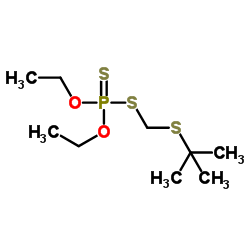特丁磷
一般危化品

特丁磷结构式
|
常用名 | 特丁磷 | 英文名 | Terfbufos |
|---|---|---|---|---|
| CAS号 | 13071-79-9 | 分子量 | 288.431 | |
| 密度 | 1.2±0.1 g/cm3 | 沸点 | 319.6±44.0 °C at 760 mmHg | |
| 分子式 | C9H21O2PS3 | 熔点 | -29°C | |
| MSDS | 中文版 美版 | 闪点 | 147.1±28.4 °C | |
| 符号 |


GHS06, GHS09 |
信号词 | Danger |
|
Fenthion and terbufos induce DNA damage, the expression of tumor-related genes, and apoptosis in HEPG2 cells.
Environ. Mol. Mutagen. 52(7) , 529-37, (2011) This study investigates the effects of fenthion and terbufos, two organophosphorous pesticides, on DNA damage, tumor-related gene expression, and apoptosis in HepG2 cells. We found that exposure to concentrations ranging from 50 to 200 μM of fenthion and terb... |
|
|
Fungal degradation of organophosphorus insecticides.
Appl. Biochem. Biotechnol. 39-40 , 715-26, (1993) Organophosphorous insecticides are used extensively in agriculture. As a group, they are easily degraded by bacteria in the environment. However, a number of them have half-lives of several months. Little is known about their biodegradation by fungi. We showe... |
|
|
Pesticide use modifies the association between genetic variants on chromosome 8q24 and prostate cancer.
Cancer Res. 70(22) , 9224-33, (2010) Genome-wide association studies have identified 8q24 region variants as risk factors for prostate cancer. In the Agricultural Health Study, a prospective study of licensed pesticide applicators, we observed increased prostate cancer risk with specific pestici... |
|
|
Interaction of insecticides, entomopathogenic nematodes, and larvae of the western corn rootworm (Coleoptera: Chrysomelidae).
J. Econ. Entomol. 91(2) , 410-8, (1998) Chemical insecticides and entomopathogenic nematodes have been independently used to suppress corn rootworm damage in maize. We report on the mortality response of larvae of the western corn rootworm, Diabrotica virgifera virgifera LeConte, to the combined tr... |
|
|
Nucleophilic reactions of phorate and terbufos with reduced sulfur species under anoxic conditions.
J. Agric. Food Chem. 55(9) , 3546-54, (2007) The reactions of phorate and terbufos with bisulfide (HS-), polysulfide (Sn2-), thiosulfate (S2O32-), and thiophenolate (PhS-) were examined in well-defined aqueous solution under anoxic conditions to investigate their role in the degradations of phorate and ... |
|
|
Toxicity of the insecticide terbufos, its oxidation metabolites, and the herbicide atrazine in binary mixtures to Ceriodaphnia cf dubia.
Arch. Environ. Contam. Toxicol. 60(3) , 417-25, (2011) The acute toxicity of terbufos and its major metabolites, tested alone, in binary mixtures or in combination with atrazine were evaluated using neonates of the cladoceran Ceriodaphnia cf dubia. Terbufos, terbufos sulfoxide, and terbufos sulfone tested individ... |
|
|
A low concentration of atrazine does not influence the acute toxicity of the insecticide terbufos or its breakdown products to Chironomus tepperi.
Ecotoxicology 19(8) , 1536-44, (2010) The acute toxicities of the insecticide terbufos and its major breakdown products individually, as binary mixtures, and in combination with the co-applied herbicide atrazine were evaluated using final instar larvae of the midge Chironomus tepperi. Terbufos, t... |
|
|
Organophosphate pesticide method development and presence of chlorpyrifos in the feet of nearctic-neotropical migratory songbirds from Canada that over-winter in Central America agricultural areas.
Chemosphere 144 , 827-35, (2015) Recent modeling analysis suggests that numerous birds may be at risk of acute poisoning in insecticide-treated fields. Although the majority of avian field studies on pesticides have focused on treated seed, granule, insect or vegetation (oral exposure) inges... |
|
|
Study of the mechanism of Flavobacterium sp. for hydrolyzing organophosphate pesticides.
Fundam. Clin. Pharmacol. 17(6) , 717-23, (2003) The biotransformation by Flavobacterium sp. of the following organophosphate pesticides was experimentally and theoretically studied: phorate, tetrachlorvinphos, methyl-parathion, terbufos, trichloronate, ethoprophos, phosphamidon, fenitrothion, dimethoate an... |
|
|
Effects of exposure time, material type, and granular pesticide on glove contamination.
Arch. Environ. Contam. Toxicol. 41(4) , 529-36, (2001) Chemical-resistant gloves are recommended for pesticide applicators to reduce their exposure to agricultural chemicals. In this research, three chemical-resistant glove materials-nitrile, neoprene, and barrier laminate-were studied in relation to contaminatio... |